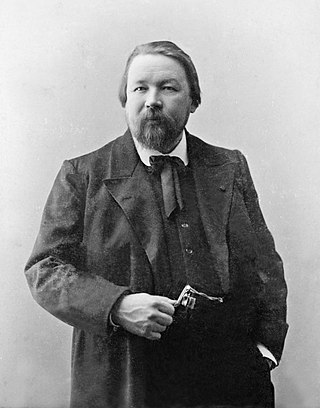Related Research Articles

Mikhail Mikhailovich Ippolitov-Ivanov was a Russian and Soviet composer, conductor and teacher. His music ranged from the late-Romantic era into the 20th century era.
Caucasian Sketches is a pair of orchestral suites written in 1894 and 1896 by the Russian composer Mikhail Ippolitov-Ivanov. The Caucasian Sketches is the most often performed of his compositions and can be heard frequently on classical radio stations. The final movement of the Caucasian Sketches, Suite No. 1, entitled Procession of the Sardar, is often heard by itself, and is a favorite of "Pops" concerts.
Sonatina, Sz. 55, BB. 69 is a piece for solo piano written in 1915 by Hungarian composer Béla Bartók. Initially entitled Sonatina on Romanian folk tunes, it is based on folk tunes Bartók collected in his neighbour country Romania, which, even though he proclaimed Hungarian folk music was clearly superior, was a direct source of inspiration all along his active years.
Romanian Folk Dances, , Sz. 56, BB 68 is a suite of six short piano pieces composed by Béla Bartók in 1915. He later orchestrated it for small ensemble in 1917 as Sz. 68, BB 76.
Turkish Fragments, Op. 62 is an orchestral suite written in 1930 by Russian composer Mikhail Ippolitov-Ivanov and published in 1931. This suite is sometimes titled as Orchestral Suite No. 3, even though there is no official numbering. This work for large orchestra was dedicated to Shevket Mamedova, an Azerbaijani soprano.
Peter Jarvis is an American percussionist, drummer, conductor, composer, music copyist, print music editor and college professor.
Pléïades is a composition for six percussionists composed in 1978 by Greek composer Iannis Xenakis, originally commissioned by the percussion ensemble Les Percussions de Strasbourg. It is notable for its use of the sixxen, an instrument Xenakis had constructed specifically for the piece.
Herzgewächse, Op. 20, is a composition by Austrian composer Arnold Schoenberg scored for coloratura soprano, celesta, harmonium, and harp. The text is taken from a poem of the same name by Maurice Maeterlinck. The duration of the work is approximately three-and-a-half minutes, making it the shortest of Schoenberg's works with its own opus number. The work is also notable for the extreme demands made on the singer which at one point has to ascend to a high F (pianissimo), nearly two-and-a-half octaves above middle C.
No-res, a Symphonic Tragedy in Two Parts, also known as No-res, an Agnostic Requiem is a cantata for choir, orchestra, narrator and magnetic tape by Barcelonan composer Leonardo Balada. This work was finished on 1974 and represents a soundscape in which the composer recreates the relationship between himself and his mother when the latter was dying, to whom the work is dedicated. The lyrics were written exclusively for this composition by French poet Jean Paris. This is one of the most relevant works from the avant-garde period of Balada.
Four Orchestral Songs, Op. 22, is a composition by Austrian composer Arnold Schoenberg, scored for soprano and large orchestra.
Caucasian Sketches, Suite No. 1, Op. 10 is an orchestral suite composed in 1894 and one of the most representative works by Russian composer Mikhail Ippolitov-Ivanov. Its final movement, titled Procession of the Sardar, is often performed as a standalone composition and is a favorite in pop concerts.
Caucasian Sketches, Suite No. 2, Op. 42 is an orchestral suite by Russian composer Mikhail Ippolitov-Ivanov written in 1896, after he moved to Moscow. The work is more commonly known by the subtitle Iveria, which is an archaic name for the country of Georgia, the folk music of which inspired the composition.
Dance Suite, Sz. 77, BB 86a, is a well-known 1923 orchestral work by the Hungarian composer Béla Bartók. The composer produced a reduction for piano in 1925, though this is less commonly performed.
Eight Improvisations on Hungarian Peasant Songs, Op. 20, Sz. 74, BB 83, also known as Improvisations on Hungarian Peasant Songs or simply as Improvisations, is a composition for solo piano by Hungarian composer Béla Bartók. It was finished in 1920.
Petite Suite, Sz. 105, BB 113 is a reduction for piano of six of Bartók's 44 Duos for Two Violins, arranged by the composer in 1936.
Romanian Christmas Carols, Sz, 57, BB 67 is a set of little colinde, typical Christmas songs from Romanian villages, habitually sung by small groups of children, adapted in 1915 by Hungarian composer Béla Bartók to be played on the piano after hearing them sung in the below villages.

The Suite is a composition for solo cello by Polish composer Krzysztof Penderecki. The piece is well known for its typical chromatic melodies and for its recurrent use of pizzicati and col legno.
Slovakian Dance is a piece for solo piano by Hungarian composer Béla Bartók. It was presumably composed in 1923, but it was not published until 1999.
The Allegretto for Piano Trio, WoO 39, in B-flat major is a composition for piano trio by Ludwig van Beethoven that was composed in 1812 as a gift for Maximiliane Brentano, the then ten-year-old daughter of his friend Antonie Brentano. Eight years later he also dedicated the Piano Sonata Op. 109 to Maximiliane. The composition was first published in 1830 by F. P. Dunst in Frankfurt, along with the Piano Trio in E-flat major, WoO 38, and the Piano Sonata in C major, WoO 51.
References
- ↑ Anderson, Keith (1995). Booklet from the CD 8.553405 from Naxos catalogue. New York: HNH International Ltd. pp. 3–4.
- ↑ Anderson, Keith (1989). Booklet from the CD 8.220217 from Naxos catalogue. Marco Polo. Retrieved July 26, 2011.
- ↑ "Tracklist from the CD 8.220217 from the Naxos catalogue". Hong Kong: Naxos Digital Services Ltd. 1990. Retrieved July 25, 2011.
- ↑ "Tracklist from the CD 8.553405 from the Naxos catalogue". Hong Kong: Naxos Digital Services Ltd. 1995. Retrieved July 25, 2011.